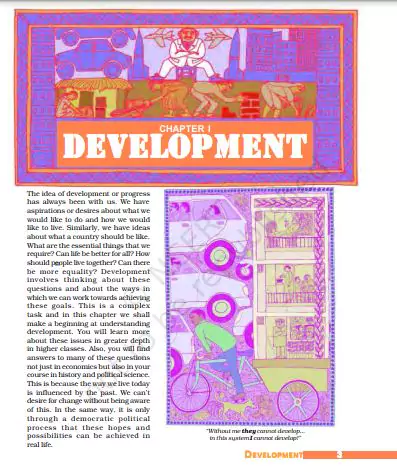‘Development Book’ PDF Quick download link is given at the bottom of this article. You can see the PDF demo, size of the PDF, page numbers, and direct download Free PDF of ‘Ncert Class 10 Social Science Chapter 1 Exercise Solution’ using the download button.
NCERT Solutions for Class 10 Social Science Chapter 1 Development PDF Free Download

Chapter 1: Development
The idea of development or progress has always been with us. We have aspirations or desires about what we would like to do and how we would like to live. Similarly, we have ideas about what a country should be like. What are the essential things that we require? Can life be better for all? How should people live together?
Can there be more equality? Development involves thinking about these questions and about the ways in which we can work towards achieving these goals. This is a complex task and in this chapter we shall make a beginning at understanding development. You will learn more about these issues in greater depth in higher classes.
Also, you will find answers to many of these questions not just in economics but also in your course in history and political science. This is because the way we live today is influenced by the past. We can’t desire for change without being aware of this. In the same way, it is only through a democratic political process that these hopes and possibilities can be achieved in real life. Having filled Table 1.1, let us now examine it.
Do all of these persons have the same notion of development or progress? Most likely not. Each one of them seeks different things. They seek things that are most important for them, i.e., that which can fulfil their aspirations or desires. In fact, at times, two persons or groups of persons may seek things which are conflicting.
A girl expects as much freedom and opportunity as her brother, and that he also shares in the household work. Her brother may not like this. Similarly, to get more electricity, industrialists may want more dams. But this may submerge the land and disrupt the lives of people who are displaced – such as tribals.
They might resent this and may prefer small check dams or tanks to irrigate their land. So, two things are quite clear: one, different persons can have different developmental goals and two, what may be development for one may not be development for the other. It may even be destructive for the other.
If you go over Table 1.1 again, you will notice one common thing: what people desire are regular work, better wages, and decent price for their crops or other products that they produce. In other words, they want more income. Besides seeking more income, oneway or the other, people also seek things like equal treatment, freedom, security, and respect of others. They resent discrimination.
All these are important goals. In fact, in some cases, these may be more important than more income or more consumption because material goods are not all that you need to live. Money, or material things that one can buy with it, is one factor on which our life depends.
But the quality of our life also depends on non-material things mentioned above. If it is not obvious to you, then just think of the role of your friends in your life. You may desire their friendship. Similarly, there are many things that are not easily measured but they mean a lot to our lives. These are often ignored.
| Author | NCERT |
| Language | English |
| No. of Pages | 16 |
| PDF Size | 0.5 MB |
| Category | Social Science |
| Source/Credits | ncert.nic.in |
NCERT Solutions Class 11 Social Science Chapter 1 Development
1. In what respects is the criterion used by the UNDP for measuring development different from the one used by the World Bank?
Answer: The criterion used by UNDP is different from the one used by the World Bank because UNDP compares countries based on the educational level of the people, their health status and per capita income. This is in contrast with the method used by the World Bank because the World Bank only calculates the per capita income for measuring development.
2. Why do we use averages? Are there any limitations to their use? Illustrate with your own examples related to development.
Answer: Different countries have a different population, so calculating the average helps in getting an estimated answer which can be used to compare different things at different levels. There are limitations of calculating averages because we cannot know the difference in the income of the people and the unfair distribution of income in a country or state.
For example, if we calculate the per capita income of two countries A and B with 5 people each, the salary of five people in country A is Rs.23,000, Rs.22,000, Rs.23,500, Rs.28,000 and Rs.25,000 and the income of people living in country B are Rs.1,50,000, Rs. 22,000, Rs.50,000, Rs.4000, Rs.2500. The average income of country A will be Rs.24,300, and that of country B will be Rs.45,700. This proves that the average of country B is higher than that of country A, and yet there is a disparity in the income distribution of country B and the income is evenly distributed in country A.
NCERT Class 11 Social Science Textbook Chapter 1 With Answer PDF Free Download
